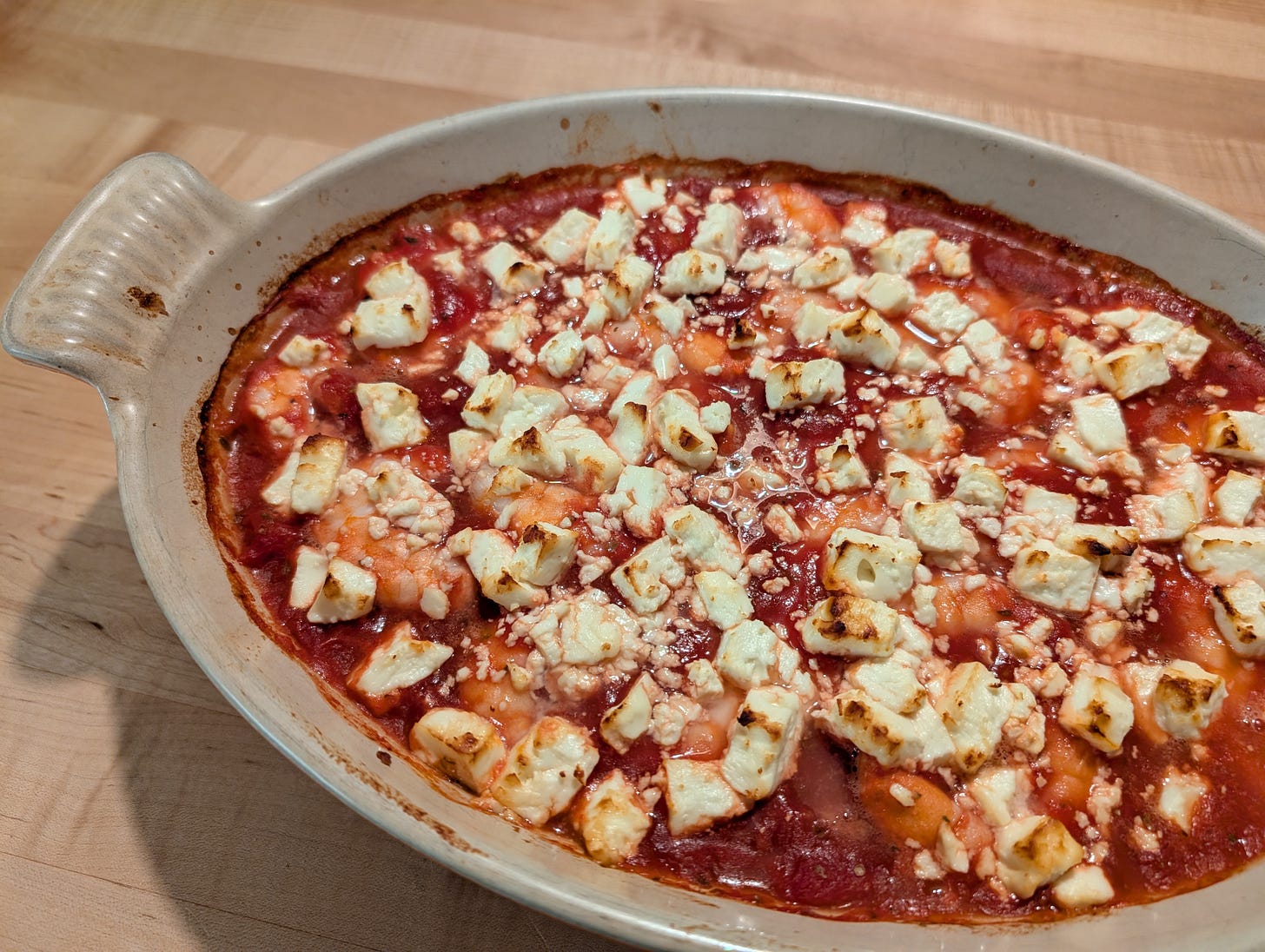Seafood and Butter
Contemplating that delicious partnership, plus a couple shrimp recipes (one buttery, one tomatoey)
This time next month I’ll be down in Sun Valley for what I think is the fifth time in the last few years, teaching some classes at the wonderful Sun Valley Culinary Institute. As has come to be the pattern, one class will have a seafood theme (echoing my professional background) and another will be inspired by French cuisine (part of my professional life, too, but also rooted in my love of all things France). In this issue I offer a little taste of what I’ll be teaching next month. And it’s actually related to the French class, not the seafood one (which will be all about oysters, a topic of frequent discussion here). I’m calling the class Butter à la Française—highlighting a few ways that butter contributes flavor and texture in cooking.
I’m a lifelong fan of butter, and must fess up to the fact that it actually started out with the oleo that was in the house when I was a kid. I’m not sure I had much true butter before I headed off to cooking school in France after college. I’ve been making up for lost time ever since.
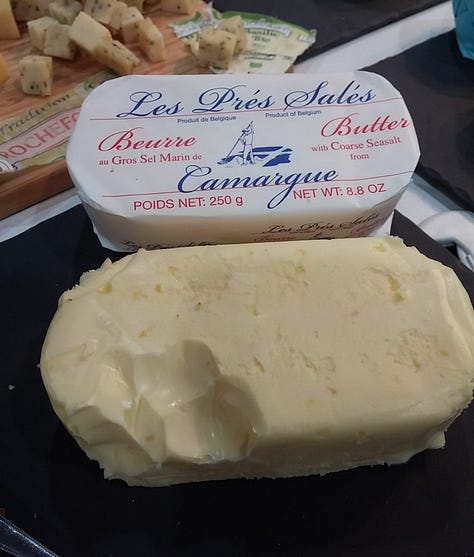
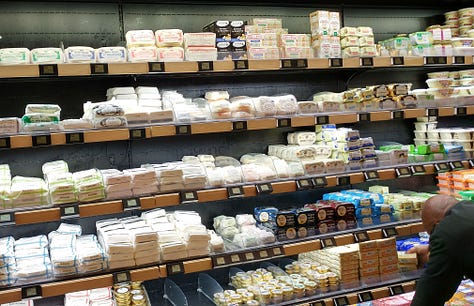

It’s easy—and completely valid—to equate butter with adding flavorful richness in baked goods or when spread on a lovely piece of bread. It also has a lot of delicious roles to play in cooking, such as a pat of flavored butter added to grilled fish before serving, or infusing flavor from other ingredients (such as shrimp shells or herbs). In an article I wrote for Cooking Light magazine years ago about flavor boosters, shrimp butter was one of the elements I featured. I’ll dive more into that technique in a future issue. And down the line I’ll also get to the British classic dish of potted shrimp: cooked shrimp packed in ramekins with melted butter and a bit of spice. How can that not be delicious? Rich, sure, but delicious.
For now, I want to chat about the delicious combo of seafood, herbs, and butter. In Shellfish, one of the recipes celebrates that trio in a particularly simple fashion: clams, fresh bay leaf (or could be other fresh herb), and a pat of butter secured in a foil packet and grilled to steam open the clams (no extra liquid needed). Such amazing flavor and aroma produced by that preparation.
The recipe I share below starts by cooking fresh rosemary leaves in melted butter until the leaves are just lightly toasted and crisp. In those few minutes of cooking, they also give off beautiful flavor to the butter which is then used to sauté shrimp with garlic. It exemplifies how the flavor of both the herb and the butter are amplified when cooked together. Plus the butter gets a bit nutty-brown in the process, even more flavor! It’s a technique I use for a range of preparations. Last night, I cooked a couple fresh bay leaves in butter for a bit, until richly aromatic and the butter lightly browned. I then added sliced carrots to cook in that butter, and added a splash or two of water after 4 or 5 minutes, simmering until water evaporated and carrots were tender. Subtle bay leaf flavor envelops the carrots along the way, through the butter and the leaves in the pan. (Unlike with the rosemary, I discard the bay leaf when cooking is done.)
On Shrimp Tails
Quick note about shrimp tails. Yes, I understand those little fanned tail ends can look nice when left on the shrimp. As I conveyed in my recent book, I’m all for keeping them on when the shrimp are being eaten with your fingers: shrimp cocktail is the perfect example, the tails provide a tidy way to pick up the shrimp. BUT once those shrimp go into a sauce or a stew—any dish that you’re not eating with your fingers—what an unnecessary mess it makes for diners to have to remove those tails while they eat. I had to laugh when I saw recently that Stephen Colbert went off on a similar rant while demoing a recipe from the new cookbook he wrote with his wife, Does This Taste Funny. I’m right there with you, Stephen. And I just found this NPR snippet from a couple of months ago in which Ina Garten agrees with him too.
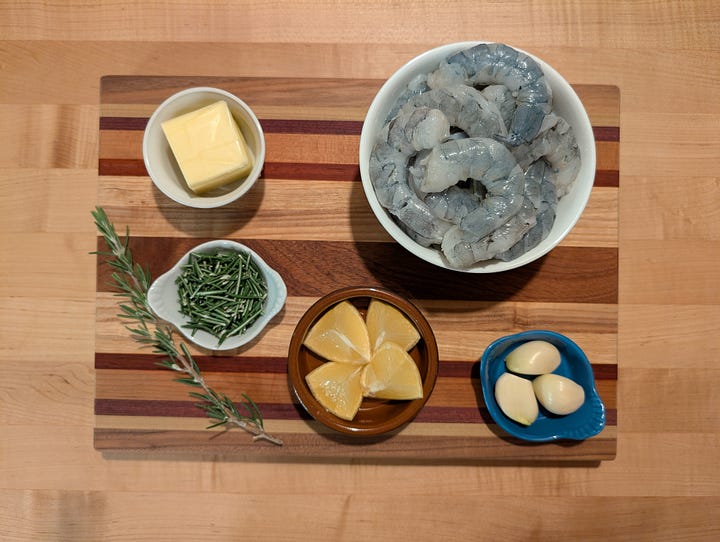
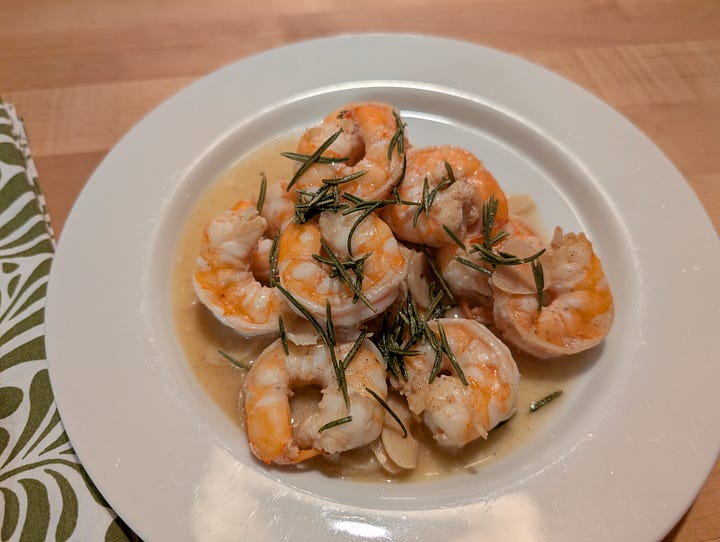
Sautéed Shrimp with Garlic and Crisp Rosemary
One of the simplest and most delicious preparations for shrimp is a quick sauté in a hot skillet, with many possibilities for ingredients and flavors that can be used. In this recipe from my cookbook Shellfish, that embellishment comes in the form of garlic and rosemary, the latter first cooked in butter until crisp.
The ingredient list makes me realize I’m overdue writing more about shrimp and/or shellfish stock. That’s on the agenda soon. For now: know that you can put the shells peeled from this pound and a half of shrimp (I know it’s quicker to buy pre-peeled, but worth the extra few minutes of peeling to have shells for a quick stock) in a pan, add just enough water to cover, a bay leaf and/or thyme sprig and/or few parsley sprigs if handy, and simmer for 20 to 30 minutes. Voilà, quick shrimp stock.
1/4 cup unsalted butter
2 tablespoons fresh rosemary leaves plucked from the stem
3 cloves garlic, thinly sliced
1 1/2 pounds medium or large shrimp, peeled and deveined
Kosher salt and freshly ground black pepper
1/2 cup dry white wine, shrimp stock, or shellfish stock
2 tablespoons freshly squeezed lemon juice
Melt the butter in a large skillet over medium heat. Add the rosemary and cook, stirring occasionally with a fork, until the rosemary is lightly crisped, aromatic, and just hints of lightly browned, about 2 minutes (too brown and it becomes a tad bitter). Note that the butter will brown as it cooks, a good thing, adding a bit of nutty flavor as well. Take the skillet from the heat and use the fork to lift out the rosemary onto a small plate, allowing excess butter to drip back into the skillet. Set the rosemary aside to cool.
Return the skillet to medium heat and add the garlic. Cook, stirring often, until aromatic, 30 to 60 seconds. Add the shrimp with a good pinch of salt and a few grindings of black pepper and cook, stirring occasionally, until the shrimp are evenly opaque on the surface, 2 to 3 minutes. Add the wine and simmer over medium-high until reduced by about half and the shrimp are just cooked through (opaque through the thickest part), 3 to 4 minutes longer. Stir in the lemon juice, taste the sauce for seasoning, and add more salt or pepper to taste.
Spoon the shrimp and sauce onto individual plates, sprinkle the crisp rosemary over, and serve right away.
Makes 4 to 6 servings
Shrimp Baked with Feta and Tomatoes
I wish I remembered where I first encountered this dish. It was years ago and became something I worked into relatively regular rotation for a quick weeknight dinner. It’s always an off-the-cuff exercise around here, as there’s not much complexity to it: whole peeled raw shrimp, tomatoes, crumbled feta, and some seasoning. Arrange it all in a shallow baking dish and bake until the shrimp are cooked through and the juices bubbly.
Though a pretty simple template, there is still plenty of room for variation and embellishment. I almost always use one small can of diced tomatoes, an upgrade to San Marzano would be even more flavorful. And as you’ll see below, last week I had half a can of tomato sauce in the fridge, so added that. I’ve never used fresh tomatoes, though imagine that summer’s vine-ripened, juicy, flavorful tomatoes would provide best results if going that route. Cherry tomatoes might work well, too.
Given the keep-it-simple mood I’m usually in when making this, I often shake in some dried thyme or oregano. Fresh versions of them certainly a great option. And I also have good onion granules and garlic granules (not as fine as powder, I stock up at the fabulous World Spice here in Seattle) on my shelf, so I often add a couple of shakes of them. Or I might add a very thinly sliced (i.e. mandolined) garlic clove or two. Another option is to sauté chopped onion and garlic until tender and mix that into the tomato base—though I’ve never bothered. Oh, and you could add a little kick from chile flakes if that’s your kind of thing.
This is how that all played out recently.
In the bottom of a 12-inch gratin dish, I stirred together:
· 1 can (14.5 oz) diced tomatoes
· 1/2 can tomato sauce
· About 1 teaspoon dried oregano
· A few generous dashes of onion granules and garlic granules
On top of that I added in a relatively even layer:
· 1 pound medium shrimp, peeled and deveined
After pressing the shrimp down into the tomato mixture a bit, I scatter over the top:
· A few ounces feta cheese, diced/crumbled
Then it was baked at 400F until the shrimp were cooked through, juices bubbly and cheese lightly browned, about 25 minutes. We usually eat this as is, though spooned over or alongside rice or pasta would be great. And/or with bread alongside to sop up the flavorful juices.





